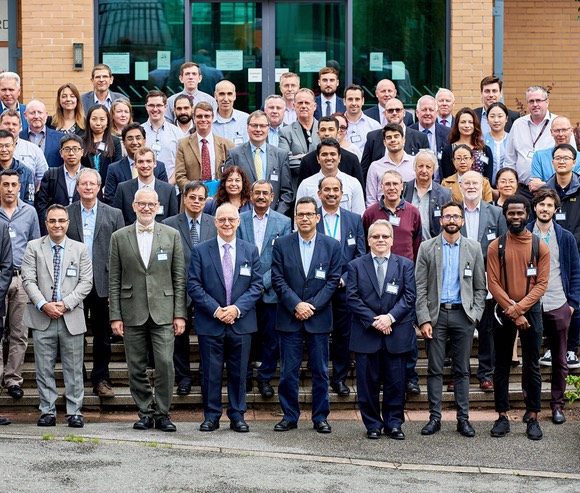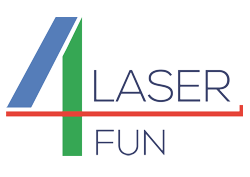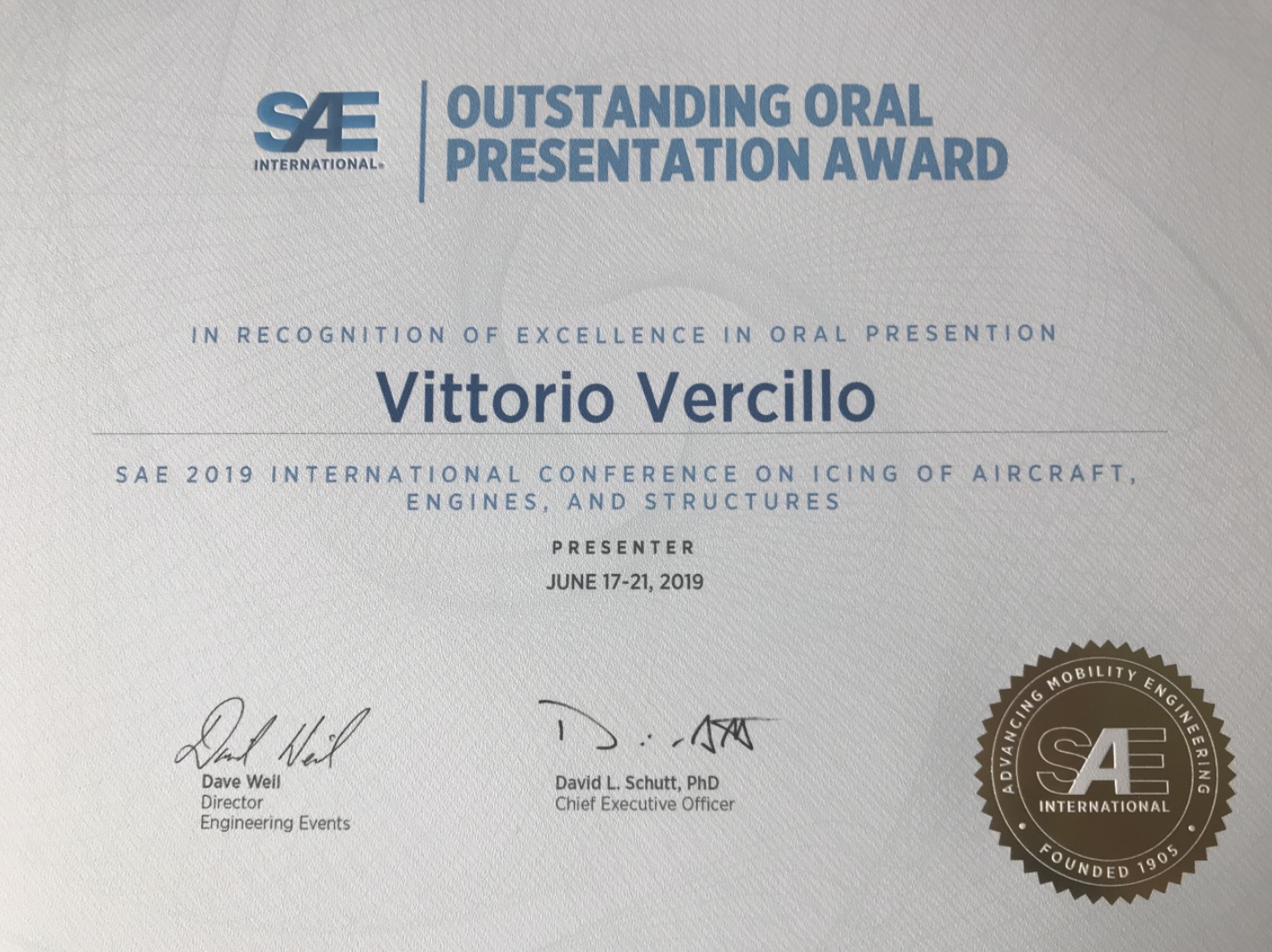PhD Researcher Marek Mezera describes his work on laser-surface texturing for self cleaning surfaces at the Chair of Laser Processing at the University of Twente.
Award for Vittorio Vercillo at SAE conference
Last June, the SAE International Conference on Icing of Aircraft, Engines, and Structures took place in Minneapolis (USA). New trends, new knowledge, and new solutions were discussed in more than 160 oral presentations that dive into every aspect of icing. Vittorio Vercillo, an Early Stage Researcher (ESR) in the Laser4Fun project, was awarded of the Outstanding Oral Presentation Award, for his contribution “Icephobic Properties of Laser-Treated Superhydrophobic Surfaces”.
More info at: https://www.sae.org/participate/awards/sae-engineering-meetings-board-outstanding-oral-presentation-award
The Role of the Surface Nano-Roughness on the Wettability Performance of Microstructured Metallic Surface Using Direct Laser Interference Patterning
Results of the work in the Laser4Fun project has been published as:
Alfredo I. Aguilar-Morales, Sabri Alamri, Bogdan Voisiat, Tim Kunze and Andrés F. Lasagni. Nano-Roughness on the Wettability Performance of Microstructured Metallic Surface Using Direct Laser Interference Patterning. Materials 2019, 12(17), 2737.
Abstract
Superhydrophobic natural surfaces usually have multiple levels of structure hierarchy, particularly microstructures covered with nano-roughness. The multi-scale nature of such a surface reduces the wetting of water and oils, and supports self-cleaning properties. In this work, in order to broaden our understanding of the wetting properties of technical surfaces, biomimetic surface patterns were fabricated on stainless steel with single and multi-scale periodic structures using direct laser interference patterning (DLIP). Micropillars with a spatial period of 5.5 µm and a structural depth of 4.2 µm were fabricated and covered by a sub-micro roughness by using ultrashort laser pulses, thus obtaining a hierarchical geometry. In order to distinguish the influence of the different features on the wettability behavior, a nanosecond laser source was used to melt the nano-roughness, and thus to obtain single-scale patterns. Then, a systematic comparison between the single- and multi-scale structures was performed. Although, the treated surfaces showed hydrophilic behavior directly after the laser treatment, over time they reached a steady-state hydrophobic condition. However, the multi-scale structured metal showed a contact angle 31° higher than the single-scale geometry when the steady-state conditions were reached. Furthermore, the impact of the surface chemistry was investigated by energy dispersive X-ray spectroscopy (EDX) and X-ray photoelectron spectroscopy (XPS) analyses. Finally, a hydrophobizing agent was applied to the laser treated samples in order to further enhance the water contact angles and to determine the pure contribution of the surface topography. In the latter case, the multi-scale periodic microstructures reached static contact angles of 152° ± 2° and a contact angle hysteresis of only 4° ± 2°, while the single-scale structures did not show superhydrophobic behavior. These results definitely suggest that multi-scale DLIP structures in conjunction with a surface chemistry modification can promote a superhydrophobic regime.
Link
PhD degree awarded to Jean-Michel Romano

On August 20th, 2019, Jean-Michel Romano successfully defended his PhD thesis, titled “Laser-based manufacturing routes for functionalizing surfaces” and was awarded the degree of Doctor of Philosophy.
The work was carried out at the University of Birmingham (UK) under the supervision of Prof. Stefan Dimov. The now Dr. Jean-Michel Romano, was an Early Stage Researcher (ESR) of the Laser4Fun project. The examination board was composed by Prof. Lin Li, Director of Laser Processing Research Centre at the University of Manchester and Dr. Nan Gao, Lecturer of Bio-medical Engineering at the Department of Mechanical Engineering at the University of Birmingham.
We congratulate Jean-Michel with this achievement!
Summary PhD thesis
Robust functional surfaces are of a growing industrial interest for a range of optical, easy-to-clean, anti-icing and non-fouling applications. At the same time, nature is a great source of inspiration for micro/nano-scale surface structures with tailored functional properties. There are a number of competing technologies for producing such structures but ultrashort laser processing is emerging as one of the most promising for fabricating bio-inspired surfaces. However, the technology has limitations and its capabilities have to be augmented to achieve the required high-throughput in manufacturing products that incorporate functional surface topographies. Therefore, this research investigates a promising process chain that combines synergistically the capabilities of laser texturing with complementary surface engineering and replication technologies. Several large-area laser texturing techniques are investigated, namely Direct Laser Writing (DLW), Laser-Induced Periodic Surface Structures (LIPSS) and microlenses-induced Photonic Jet (PJ) texturing. The research advances the knowledge in laser-based surface functionalization and also in factors affecting the functional response and durability of laser structured surfaces.
Link
https://etheses.bham.ac.uk//id/eprint/9740/1/Romano2019PhD.pdf
Fabricating Laser-Induced Periodic Surface Structures on Medical Grade Cobalt–Chrome–Molybdenum: Tribological, Wetting and Leaching Properties
Results of the work in the Laser4Fun project has been published as:
van der Poel, S.H., Mezera, M., Römer, G.R.B.E., de Vries, E.G., Matthews, D.T.A., Fabricating Laser-Induced Periodic Surface Structures on Medical Grade Cobalt–Chrome–Molybdenum: Tribological, Wetting and Leaching Properties. Lubricants 2019, 7(8), 70.
Abstract
Hip-implants structured with anti-bacterial textures should show a low-friction coefficient and should not leach hazardous substances into the human body. The surface of a typical material used for hip-implants, namely Cobalt–Chrome–Molybdenum (CoCrMo) was textured with different types of laser-induced periodic surface structures (LIPSS)—i.e., low spatial frequency LIPSS (LSFL), hierarchical structures consisting of grooves superimposed with high spatial frequency LIPSS (HSFL) and Triangular shaped Nanopillars (TNP)—using a picosecond pulsed laser source. The effect of LIPSS on the wettability, friction, as well as wear of the structures, when slid against a polyethylene (PE) counter surface and biocompatibility was analyzed. Surfaces covered with LSFL show superhydrophobicity and grooves with superimposed HSFL, as well as TNP, show hydrophobic behavior. The coefficient of friction (CoF) of LIPSS against a polyethylene (PE) counter surface was found to be higher (ranging from 0.40 to 0.66) than the CoF of (polished) CoCrMo, which was found to equal 0.22. It was found that the samples release cobalt within biocompatible limits. Compared to polished reference surfaces, LIPSS cause higher friction of CoCrMo against PE contact. However, the wear of the PE counter surface only increased significantly for the LSFL textures. For these reasons, it is concluded that LIPSS are not suitable for a heavily loaded metal-on-plastic bearing contact.
Link
Springtail-Inspired Triangular Laser-Induced Surface Textures on Metals Using MHz Ultrashort Pulses
Results of the work in the Laser4Fun project has been published as:
Romano, J.M., Helbig, R., Fraggelakis, F., Garcia-Giron, A., Werner, C., Kling, R., Dimov, S., Springtail-Inspired Triangular Laser-Induced Surface Textures on Metals Using MHz Ultrashort Pulses. J. Micro Nano-Manuf 2019, 7(2), 024504.
Abstract
Considering the attractive surface functionalities of springtails (Collembola), an attempt at mimicking their cuticular topography on metals is proposed. An efficient single-step manufacturing process has been considered, involving laser-induced periodic surface structures (LIPSS) generated by near-infrared femtosecond laser pulses. By investigating the influence of number of pulses and pulse fluence, extraordinarily uniform triangular structures were fabricated on stainless steel and titanium alloy surfaces, resembling the primary comb-like surface structure of springtails. The laser-textured metallic surfaces exhibited hydrophobic properties and light scattering effects that were considered in this research as a potential in-line process monitoring solution. The possibilities to increase the processing throughput by employing high repetition rates in the MHz-range are also investigated.
Link(s)
Jean-Michel Romano attended PPE 2019
On July 9-10th, Jean-Michel Romano (ESR) presented part of the results of the Laser4fun project at the Polymer Process Engineering PPE’19. The event was organised by the Polymer IRC in Bradford (UK).

Avoiding Starvation in Tribocontact Through Active Lubricant Transport in Laser Textured Surfaces
Results of the work in the Laser4Fun project has been published as:
Tobias Stark , Thomas Kiedrowski, Holger Marschall and Andrés Fabián Lasagni. Avoiding Starvation in Tribocontact Through Active Lubricant Transport in Laser Textured Surfaces. Lubricants 2019, 7(6), 54.
Abstract
Laser texturing is a viable tool to enhance the tribological performance of surfaces. Especially textures created with Direct Laser Interference Patterning (DLIP) show outstanding improvement in terms of reduction of coefficient of friction (COF) as well as the extension of oil film lifetime. However, since DLIP textures have a limited depth, they can be quickly damaged, especially within the tribocontact area, where wear occurs. This study aims at elucidating the fluid dynamical behavior of the lubricant in the surroundings of the tribocontact where channel-like surface textures are left after the abrasion wear inside the tribocontact area. In a first step, numerical investigations of lubricant wetting phenomena are performed applying OpenFOAM. The results show that narrow channels (width of 10 μm) allow higher spreading than wide channels (width of 30 μm). In a second step, fluid transport inside DLIP textures is investigated experimentally. The results show an anisotropic spreading with the spreading velocity dependent on the period and depth of the laser textures. A mechanism is introduced for how lubricant can be transported out of the channels into the tribocontact. The main conclusion of this study is that active lubricant transport in laser textured surfaces can avoid starvation in the tribocontact.
Link(s)
How to Tailor Structural Colors for Extended Visibility and White Light Generation Employing Direct Laser Interference Patterning
Results of the work in the Laser4Fun project has been published as:
Storm, S., Alamri, S., Soldera, M., Kunze, T., Lasagni, A. F., How to Tailor Structural Colors for Extended Visibility and White Light Generation Employing Direct Laser Interference Patterning. Macromol. Chem. Phys. 2019, 1900205.
Abstract
The appearance of a surface can be controlled by creating periodic microstructures designed to diffract light and produce structural colors. Nevertheless, since structural coloration is based on diffraction, the produced colors have a strong dependence on the viewing angle and absence of coloration takes place while tilting the samples. In this work direct laser interference patterning is used to firstly provide transparent polymer sheets a structural coloration with a high‐range observation angle, and secondly to demonstrate the combination of structural colors, producing a white coloring effect. The employed approaches are based on the fabrication of micro‐gratings with multiple periods in the same structured area and on the engineering of the diffraction orders of the diffraction spectrum. The patterned surfaces are characterized by confocal microscopy and angular spectrometry in reflection mode. The morphological characterization shows homogeneous surface patterns, while the spectral results demonstrate that combining four spatial periods on a single patterned surface, a white appearance is obtained over an angular observation range higher than 30°. The experimental results are supported by theoretical predictions by means of generalized formulas based on the diffraction of light.
Link(s)
Video: Hydrophobiticy of DLIP functionalized surface on stainless steel
The Direct Laser Interference Patterning (DLIP) technique has been used to create a functionalized surface on stainless steel (black area). In combination with an additional post-treatment, the metal surface has extremely water-repellent properties with contact angles of over 150 degrees. The microscopic surface exhibits “miniature mountains” that create a superhydrophobic surface, similar to its natural pendent on a lotus leaf. The sample was placed under water (no wetting of the structured areas is observed) to emphasize the water repellency. Consequently, even if the surface gets wet, it actually stays dry in the laser processed areas. Finally, DLIP allows for self-cleaning properties on technological surfaces at industrially-relevant throughput.

